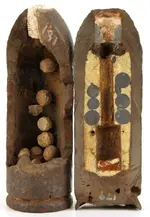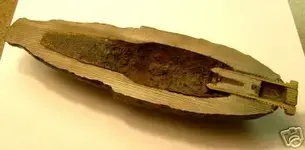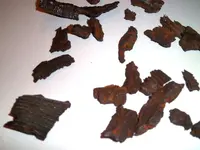I'll reply about your various artillery-shell fragments. Unfortunately, the ruler in the photo is very close to the camera lens and the frags are a good bit further back from it... whuich makes the ruler useless for we viewers trying to accurately judge the size and thickness of the fragments. Fortunately, I recognize the exploded shell base as a 2.9"-caliber US Read-Parrott shell's base. The thickness of side-frags from that 2.9"-caliber shell and its Confederate counterpart (a 2.9" CS Read Long-Model shell) are usually about 7/16th-inch thick. If the other straight-sided cylindrical frags in the photo are a little thicker than 1/2" but less than 3/4" they are from a "20-Pounder" (3.67"-caliber) US Read-Parrott, US Parrott, or CS Read Long-Model 3.67"-caliber shell. (I said "straight-sided" because Schenkl Percussion shell side-frags tend to be a bit curved along their length.) See the photos of sawed-in-half shells, below.
The roundshell frag in front of the shell-base appears to be either a 6-Pounder or 12-Pounder caliber Case-Shot frag.
The Heavy Caliber roundshell frag's thickness, compared to the known size of your 2.9"-caliber shell-base next to it, appears to be greater than 1.7-inches, which is the shellwall thickness of a 9"-caliber yankee Navy roundshell. If that guess about your big-ball frag's thickness is correct (thicker than 1.7-inches), it must be from either a 10" or 11"-caliber roundshell. (It's not thick enough to be from a 13" or 15" roundshell.)










